Key takeaways:
- Power supply units (PSUs) are critical for system reliability, affecting performance and hardware longevity.
- Efficiency ratings, such as 80 Plus certifications, lead to cost savings, reduced heat generation, and longer component lifespans.
- Choosing the right wattage and ensuring quality components is essential to avoid power issues, especially during upgrades.
- Regular maintenance, including cleaning and monitoring usage, helps prevent common PSU problems like overheating and failures.
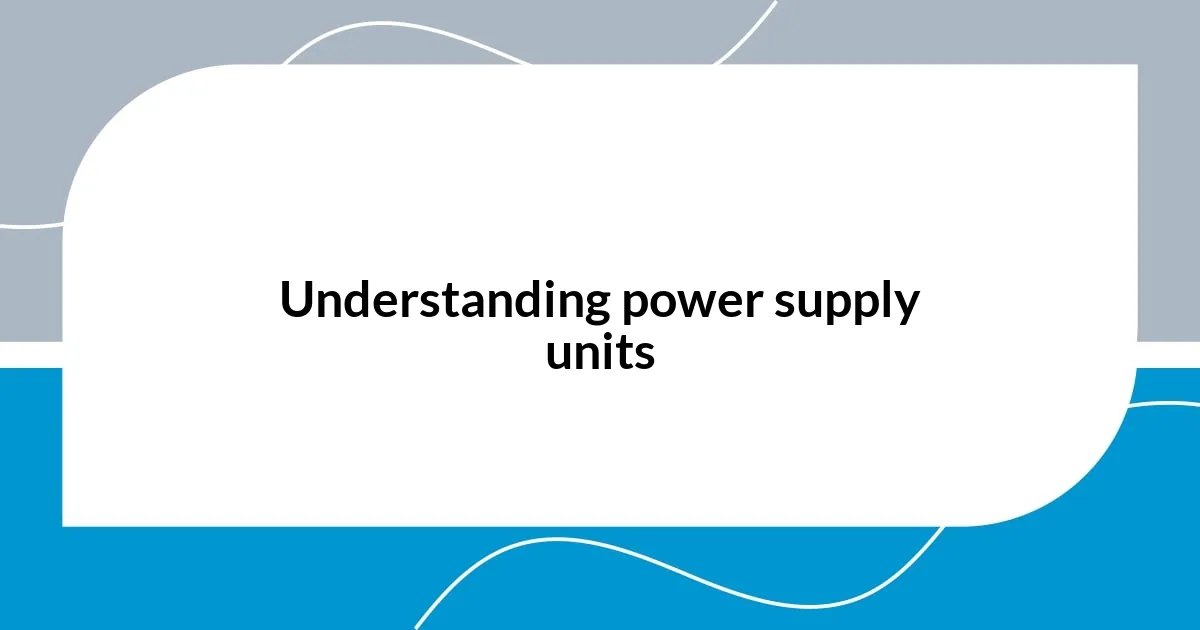
Understanding power supply units
Power supply units (PSUs) are often underestimated components in our devices, but they play a pivotal role in ensuring reliable power. I remember the first time I built my own PC; I was so excited to pick out the flashy components, but I almost overlooked the PSU. It wasn’t until a friend reminded me of its importance that I realized a high-quality power supply can prevent potential damage to all those hard-earned components.
When working with PSUs, it’s crucial to understand their specifications, like wattage, efficiency certifications, and connector types. A PSU that’s too weak can lead to system crashes or hardware damage, and that panic when your computer suddenly shuts down is something I hope you never experience. Have you ever considered how a stable power source can affect the lifespan of your devices? It’s fascinating to think that what often sits quietly inside a case has such a monumental impact on performance and longevity.
Moreover, efficiency ratings, like 80 Plus certifications, indicate how well a PSU converts power from the wall into usable energy for the system. I’ve noticed that investing in a more efficient unit not only reduces my electricity bill but also keeps my setup running cooler, which is a huge plus during those long gaming sessions! It’s like having peace of mind knowing that my system is both dependable and cost-effective.
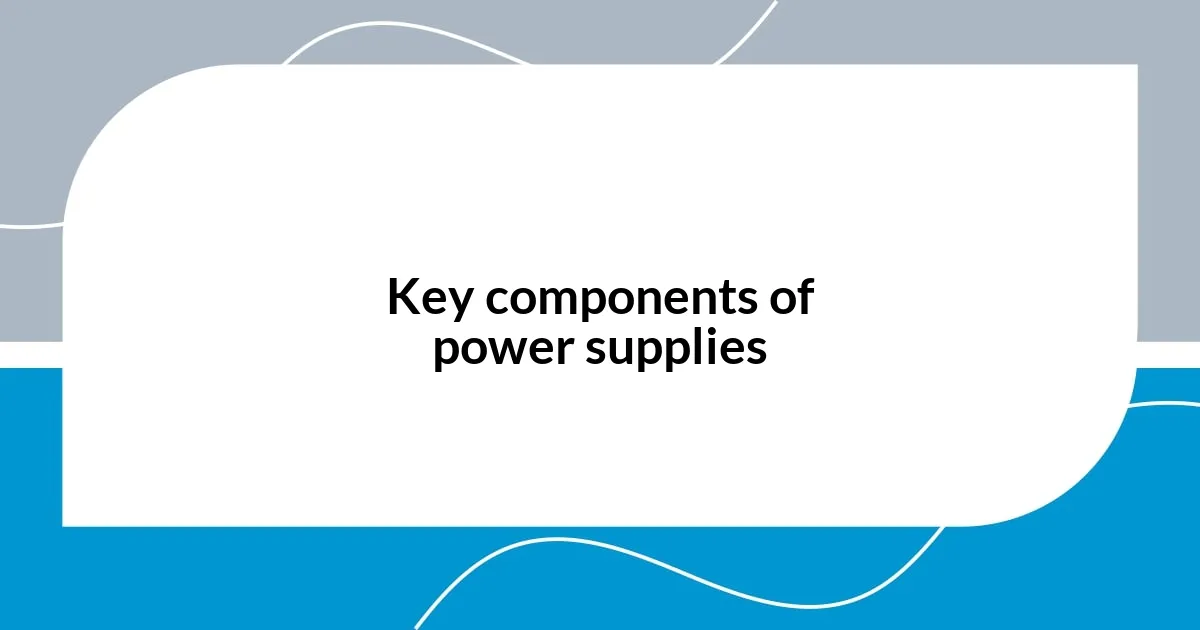
Key components of power supplies
The key components of power supplies are integral to their functionality and reliability. One crucial part is the transformer, which converts the voltage from the wall outlet to a level suitable for your device. When I first learned about transformers, it felt a bit like unlocking a secret; this single component can determine whether your computer gets the right amount of power or faces potential issues.
Another important component is capacitors. They serve as energy buffers, providing power stability during demand spikes. I recall a time when I neglected to check the capacitor quality in a PSU—it ended with unexpected shutdowns during intensive tasks. It was such a frustrating experience! Now, I make it a point to ensure that any power supply I consider has high-quality capacitors, knowing how much they influence the overall performance and reliability.
Lastly, the cooling fans are vital for maintaining an optimal temperature within the unit. Without adequate cooling, both the PSU and connected components can overheat, leading to significant performance issues. I vividly remember watching my first PSU struggle with inadequate cooling, causing all sorts of system instability. Since then, I always prioritize PSUs with robust cooling systems, especially for power-hungry builds.
| Component | Function |
|---|---|
| Transformer | Converts high voltage to usable levels |
| Capacitors | Stabilize power during demand spikes |
| Cooling Fans | Prevent overheating and maintain performance |
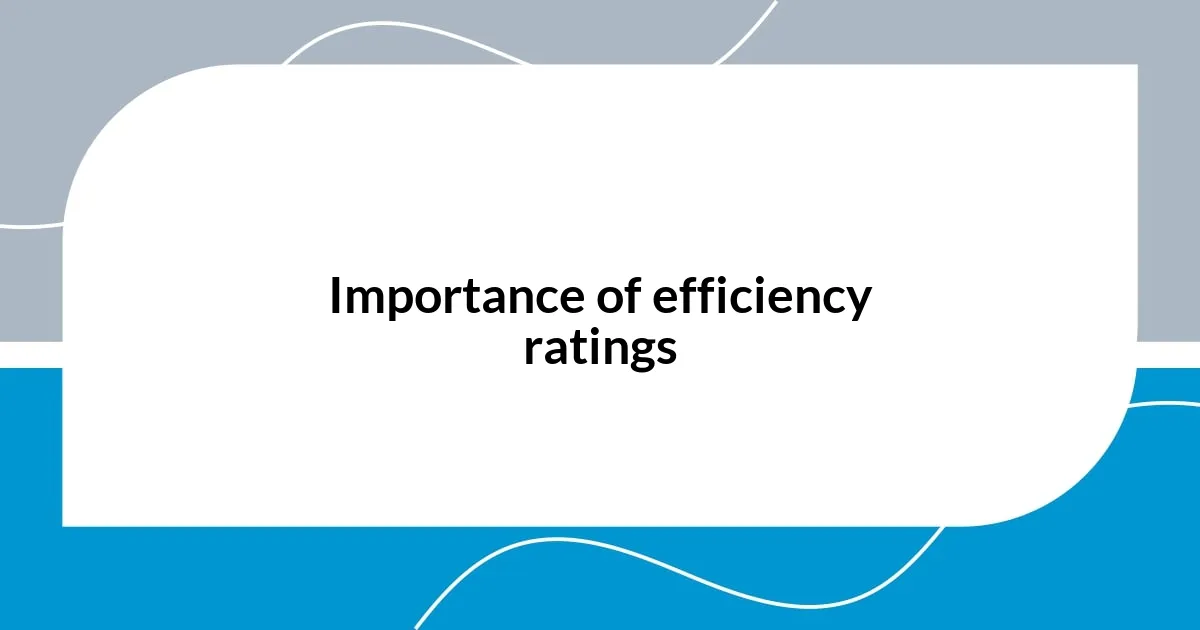
Importance of efficiency ratings
When it comes to power supply units, efficiency ratings are more than just numbers; they directly impact both your wallet and overall system performance. I remember the excitement of upgrading my setup and the relief I felt when I chose a PSU with a solid efficiency rating. The immediate savings on my energy bill were not only satisfying but gave me a sense of accomplishment, knowing I made a wise investment. A PSU with a high efficiency rating not only minimizes wasted energy but also translates into less heat generation, which in turn prolongs the life of the components.
- Cost savings: Higher efficiency means lower energy bills.
- Heat generation: More efficient PSUs produce less heat, enhancing system stability.
- Longevity: Reduced strain on components leads to longer lifespans for your hardware.
Efficiency ratings, particularly those verified by the 80 Plus certification program, reflect how well a PSU performs under varying loads. I’ll never forget the time I tried to save a few bucks on a lower-rated unit. It failed to provide the needed power, which caused random shutdowns during critical moments. That experience taught me the true value of efficiency ratings—the assurance that my system remains reliable and runs smoothly, even under heavy use.

Choosing the right wattage
Choosing the right wattage for your power supply unit (PSU) is essential to keep your system running smoothly. From my experience, I’ve learned that calculating the total wattage needed isn’t just about crunching numbers—it’s about understanding your components. For instance, when I built my first gaming rig, I underestimated the requirements and ended up with a PSU that struggled to keep up, leading to unexpected crashes during intense gaming moments. Have you ever faced a frustrating power issue like that?
Most gamers and builders often overlook the future as well. I’ve made it my mantra to leave a cushion in wattage when selecting a PSU; typically, aiming for around 20% extra is a safe bet. It ensures that when I upgrade components later, I won’t have to scramble for a new power supply. Think about it; nothing is worse than realizing you need more power right after a major investment in new hardware.
Also, consider the quality of the PSU. When I was once seduced by a cheap, high-wattage option, I quickly learned a hard lesson. While it had impressive specifications, it lacked reliability, and I dealt with system instability that felt like the universe was conspiring against me. The experience reminded me that with PC building, it’s not just about the wattage; I focus on reputable brands and their consistent performance to truly safeguard my setup.
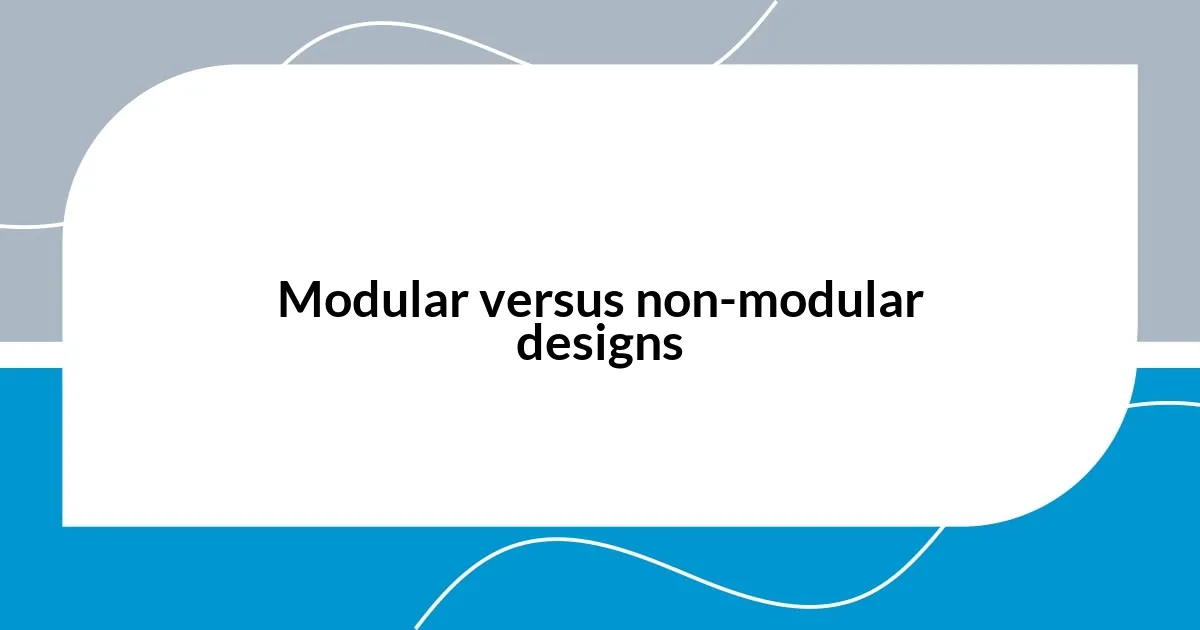
Modular versus non-modular designs
Modular designs allow you to connect only the cables that your system requires, which I find incredibly handy. For instance, I remember the first time I built a clean-looking PC. Instead of a tangled mess of wires everywhere, I used a modular PSU and couldn’t believe how much easier it made my build. The satisfaction of a tidy setup has a huge impact on both aesthetics and airflow, contributing to better overall performance.
On the other hand, non-modular power supply units come with all their cables permanently attached. I have to admit, my experience with a non-modular unit taught me some patience. While it delivered reliable power, I often found myself wrestling with unnecessary cables that cluttered my case. Have you ever tried to squeeze your hand in there to manage cables? It can be a workout! While they might be cheaper, the lack of flexibility can quickly become a hassle during upgrades or maintenance.
Ultimately, choosing between modular and non-modular designs boils down to personal preference and the specifics of your build. When I finally made the switch to a fully modular PSU, I felt like a weight had lifted. It’s fascinating how a better cable management approach can not only enhance the visual appeal of your setup but also make future upgrades much less daunting. If you’re like me and enjoy customizing your build, the modular option might just be the way to go.
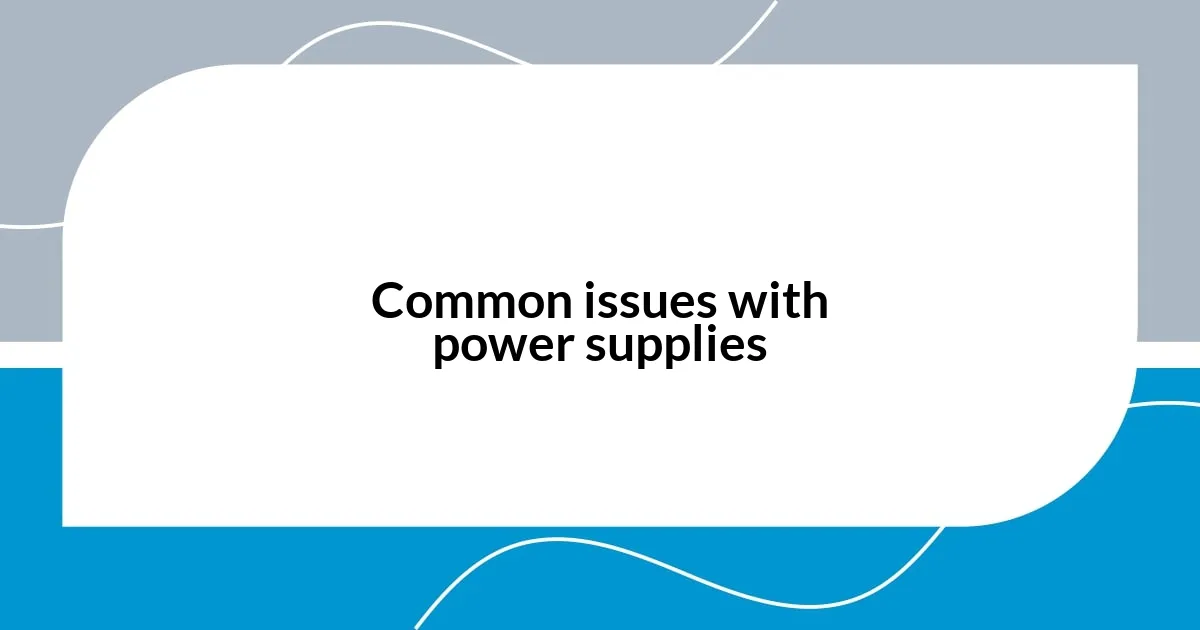
Common issues with power supplies
Power supplies, despite their simple external appearances, can often be the source of frustrating problems. One common issue I’ve encountered is overheating. Early in my PC-building journey, I remember a summer where my system overheated, causing frequent shutdowns. This experience reinforced the need for proper airflow and ventilation around the PSU. How often do we glance over such details, thinking it won’t happen to us?
Another frequent concern is cable failure. In my first build, I had a poorly made power cable that caused intermittent issues, leading to random restarts. It was a nightmare during gaming sessions. After that, I became meticulous about checking the quality and condition of the cables before using them. I can’t stress enough how essential it is to invest in high-quality cables—they’re the lifeline of your components!
Moreover, compatibility surprises can happen if you’re not careful. I once bought a PSU that seemed perfect, only to realize that the connectors didn’t fit my motherboard. It was a moment of sheer frustration! To avoid such headaches, I always double-check the compatibility of the PSU with all my components before making a purchase. It’s all about putting in a little effort up front to save a ton of hassle down the line. What about you? Have you double-checked your PSU compatibility lately?
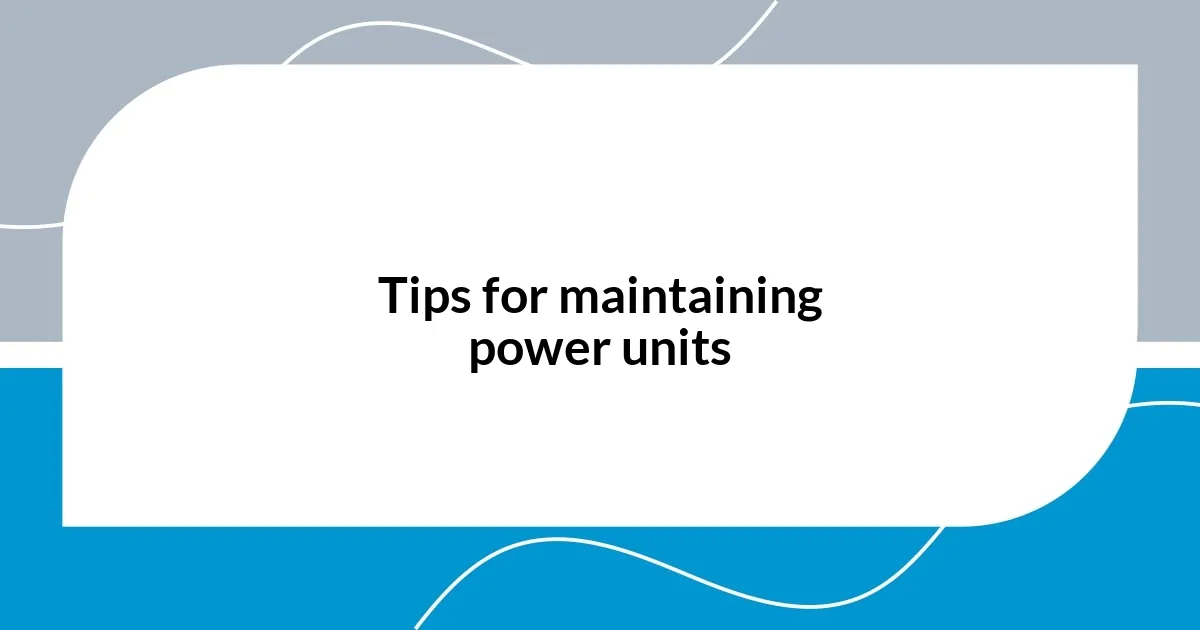
Tips for maintaining power units
To keep your power supply unit in top shape, regular cleaning is key. I remember my first dusty rig—I opened it up only to find my PSU coated with a layer of grime. It created a mini panic since I wasn’t sure if it had been affected. On a monthly basis, I now take a soft brush to the unit and can honestly say it enhances my peace of mind! What about you? When was the last time you gave your PSU a thorough cleaning?
Another solid tip is to monitor your PSU’s usage. During one particularly demanding gaming session, I noticed my system lagging, which I later traced back to the PSU working overtime. Keeping an eye on the power consumption helps me decide if I need to upgrade to a more robust unit. It’s amazing how liberating it feels to avoid the panic of a potential failure just by being a bit proactive!
Lastly, consider investing in a surge protector. I once lost a beloved gaming rig to a power spike, and it stung like nothing else. Now, I make it a priority to use surge protection to shield my equipment and extend its lifespan. Have you thought about how much your setup could benefit from this simple addition? It’s a small investment for the peace of mind it brings!